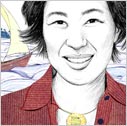From the Discover Archives: Héctor Tobar Recommends

This is what we said when we chose Héctor Tobar’s Barbarian Nurseries for the Holiday 2011 season of Discover Great New Writers:
“In this ambitious, vibrant novel set in Southern California, Pulitzer-prize winning journalist Héctor Tobar–lifelong Angeleno and modern-day Trollope–calls out major American flashpoints: race, class, and immigration.Misguided assumptions, the recession, and ill-considered, over-rationalized decisions strecth the Torres-Thompson’s household to breaking. Here success is measured solely by extternal markers: the house and expensive garden, the birthday parties and household staff. Eventually clashes driven by money and misinformation, isolation and dislocation, entitlements and resentment generate events that serve as a stinging commentary on lives led on autopilot.”
And over at the B&N Review:
“Some novels are so teeming with energy they seem to contain whole cities. Noisy, beautiful, irritating, pulsing planets full of immigrants and original sons and daughters: hucksters, winos, wisenheimers, and lost souls. Without the dimension added by these imaginary communities, our real metropolises would be impoverished, reduced to their simplest myths and glossiest images.
No city in America has needed such a book quite like Los Angeles. Its long boulevards and metal-gated shotgun houses, its water thieves and hustlers and Mexicanos have been occluded in fiction. Héctor Tobar’s second novel, The Barbarian Nurseries, brings them all beautifully into view in a book so big you can get lost here. It tells a grand story, bulging with dozens of minor characters and one unforgettable heroine.”
(And if you missed it last fall, Tobar’s terrific appearance on NPR’s Morning Edition.)
We asked Héctor to talk to us about 3 books he frequently recommends, and this is what he told us:

Before tackling Don Quixote, Edith Grossman made a name for herself as the translator of such modern Latin American literary heavyweights as Mario Vargas Llosa and Gabriel García Márquez. In her hands, Cervantes’ four-century-old masterpiece feels alive, modern and intimate. I carried this 900-page plus tome around with me for about a year, savoring each chapter. Don Quixote, I soon realized, is at once a work of realism and a celebration of the power of the imagination to reveal human passions and suffering. It was written at the beginning of the 17th century, but with each of La Mancha knight’s delusion-driven encounters on those timeless roads of rural Spain, and with each of Grossman’s lucid pages, the book feels more relevant—and strangely subversive. Stop reading stupid escapist novels, Cervantes is telling us, because the real, “ordinary” world around you is infinitely more interesting. Don Quixote’s true foil in this book is not another knight, but down-and-out Spain itself, and the cruelties, and the oddities and the obsessions of Cervantes’ time.
 The Distance Between Us by Reyna Grande
The Distance Between Us by Reyna Grande
Reyna Grande’s memoir of her childhood and adolescence in small-town Mexico and working-class Los Angeles is at once sorrowful and uplifting. Many modern Latino immigrant narratives are sentimental accounts of the protagonists’ triumphs over poverty, or descriptions of the colorful, tropical cultures from which the authors hail. In this decidedly unsentimental book, poverty is a beast that torments child and adult alike. When The Distance Between Us opens in the early 1980s, Reyna is a girl of four in provincial Iguala, Mexico with no memories of her father: he left years ago for Los Angeles to make his dreams come true “on the other side.” When her mother leaves for L.A. too, Reyna bonds with her older sister to survive ringworms, a cruel grandmother and a flooding river in Iguala. Finally, young Reyna heads for to L.A., where she is reunited with her father. He turns out to be an embittered alcoholic who is unable to fully free himself of the psychological shackles of his own, austere childhood. Here, at last, is a book in which the undercurrent of pain, loss and violence that haunts many an immigrant family comes to the surface. It’s been a long time since a book brought so many tears to my eyes.

Invisible Cities is one of the books that made me a novelist. I first read it in the late 1980s, when I was a young street reporter covering the poorer districts of my hometown for The Los Angeles Times. The conceit of Invisible Cities is that a young Venetian traveler named Marco Polo is sitting in the garden of Kublai Khan, describing the wonders of the emperors’ cities. What emerges is a kind of prose poem to “the city” as the ultimate expression of collective human creativity. Calvino celebrates the cultural and aesthetic collisions of his imagined cities, and the mysteries waiting to be uncovered by wandering through them. “The city…does not tell its past, but contains it like the lines of a hand, written in the corners of the streets, the gratings of the windows, the banisters of the steps…the poles of the flags, every segment marked in turn with scratches, indentations, scrolls.” As a reporter, I took those words of Calvino and taped them to my cubical—and then I wandered about my own city with eyes of wonder, searching for the secrets etched into the landscape.
Cheers, Miwa

Miwa Messer is the Director of the Barnes & Noble Discover Great New Writers program, which was established in 1990 to highlight works of exceptional literary quality that might otherwise be overlooked in a crowded book marketplace. Titles chosen for the program are handpicked by a select group of our booksellers four times a year. Click here for submission guidelines.